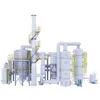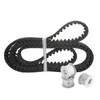An RTO, or Regenerative Thermal Oxidizer, is an advanced air pollution control system designed to destroy hazardous air pollutants (HAPs), volatile organic compounds (VOCs), and odorous emissions from industrial exhaust streams. It operates by heating the contaminated air to a high temperature in a combustion chamber, where the pollutants are oxidized into harmless carbon dioxide and water vapor. The key feature of an RTO is its energy-efficient regeneration process, which uses ceramic heat exchange media to capture and reuse heat from the cleaned exhaust, significantly reducing fuel consumption. This makes RTO systems highly cost-effective and environmentally friendly for industries requiring continuous emission control.
The operation of an RTO involves several stages to ensure efficient destruction of pollutants. Contaminated air enters the system through an inlet manifold and passes through one of multiple heat exchange chambers filled with ceramic media. Here, the air is preheated by the stored heat from previous cycles. It then moves into the combustion chamber, where burners raise the temperature to typically between 815°C and 980°C (1500°F to 1800°F), oxidizing the VOCs and HAPs. The cleaned hot air exits through another heat exchange chamber, transferring its heat to the ceramic media before being released to the atmosphere. A valve system alternates the flow direction periodically to maximize heat recovery, achieving thermal efficiencies of up to 95%. This cyclic process ensures consistent performance with minimal energy input, making RTOs ideal for high-flow, low-concentration air streams.
When selecting an RTO, it's essential to consider various technical parameters to ensure it meets specific industrial needs. Below is a detailed list and table outlining critical specifications.
| Parameter | Typical Range | Units | Notes |
|---|---|---|---|
| Destruction Efficiency | 99% - 99.9% | % | Varies with compound type and concentration |
| Thermal Efficiency | 85% - 95% | % | Higher efficiency reduces operating costs |
| Operating Temperature | 815 - 980 | °C | Adjustable based on pollutant profile |
| Pressure Drop | 10 - 25 | inches H2O | Impacts fan energy consumption |
| Flow Rate | 5,000 - 200,000 | SCFM | Customizable for larger applications |
| Fuel Consumption | 0.5 - 2.0 | MMBtu/ton VOC | Depends on inlet temperature and heat recovery |
| Ceramic Media Type | Alumina/Silica | N/A | High thermal capacity and durability |
| Warranty Period | 1 - 2 | years | Covers major components |
RTOs are widely used across various industries due to their efficiency and reliability. Common applications include chemical manufacturing, pharmaceuticals, food processing, printing, coatings, and automotive production. They are particularly effective for processes emitting large volumes of air with low to moderate concentrations of VOCs, such as painting booths, drying ovens, and chemical reactors. By complying with environmental regulations like the Clean Air Act in the U.S., RTOs help companies avoid fines and promote sustainable operations. Their adaptability allows for integration into new or existing facilities, with options for skid-mounted or custom-built designs to fit space constraints.
What is the typical lifespan of an RTO system?
With proper maintenance, an RTO system can last 20 years or more. Regular inspections, ceramic media replacement every 5-10 years, and timely burner servicing are key to longevity.
How often does an RTO require maintenance?
Maintenance intervals vary based on usage, but generally, inspections should occur quarterly, with comprehensive annual check-ups. Components like valves and filters may need more frequent attention in high-dust environments.
Can an RTO handle high concentrations of VOCs?
Yes, but concentrations above 25% Lower Explosive Limit (LEL) may require additional safety measures, such as dilution air or pre-treatment, to prevent combustion risks. Most RTOs are designed for concentrations below this threshold.
What is the cost of operating an RTO?
Operating costs depend on factors like fuel prices, electricity for fans, and maintenance. On average, fuel costs can range from $5 to $20 per hour for natural gas, but high thermal efficiency minimizes this expense.
Are RTOs environmentally friendly?
Absolutely. RTOs destroy pollutants rather than transferring them, reducing greenhouse gas emissions compared to other methods. They also recover heat, which can be reused in processes, lowering overall energy consumption.
How does an RTO compare to other oxidizers like catalytic oxidizers?
RTOs are more efficient for low-concentration, high-flow streams and have higher destruction rates, while catalytic oxidizers may be better for high-concentration streams but require catalyst replacement and are sensitive to poisons.
What regulations govern RTO emissions?
In the U.S., RTOs must comply with EPA standards under the Clean Air Act, including NESHAPs and MACT standards. Local regulations may also apply, so it's crucial to consult environmental agencies.
Can an RTO be customized for specific needs?
Yes, manufacturers offer customizations in size, materials, flow capacity, and control systems to match unique industrial processes and space requirements.
What are the common challenges with RTO operation?
Issues can include ceramic media blockage, valve leaks, or temperature fluctuations. Proper design, installation, and training mitigate these risks, ensuring smooth operation.
Is an RTO suitable for intermittent operation?
While designed for continuous use, RTOs can handle intermittent operations with proper cycling controls, though frequent startups may increase wear and energy use.



